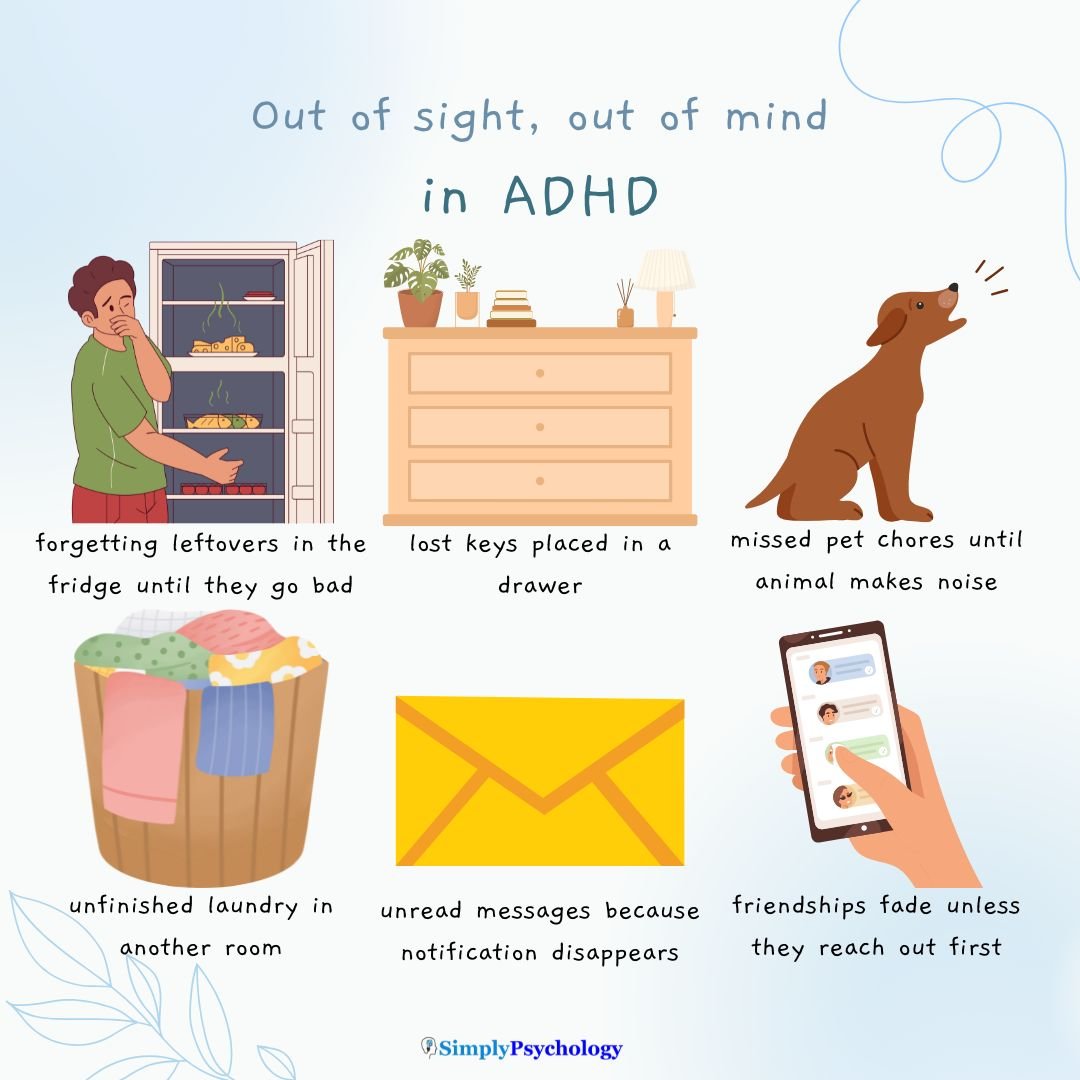Do you often put items away in a drawer and feel like you forget about them because they are hidden away?
This is a common occurrence for people with ADHD, which has often been labelled in ADHD communities as lacking “object permanence.”
But do people with ADHD actually lack object permanence? Not in the developmental sense.
Object permanence refers to a child’s understanding that things continue to exist even when out of sight—a concept typically mastered in infancy.
Adults with ADHD clearly know their keys, fridge, or friends don’t vanish when unseen.
So why does the phrase “object permanence” come up so often in ADHD communities, and is there a better way to describe what they are experiencing?

What Is ‘Object Permanence’ in ADHD?
In developmental psychology, object permanence refers to a baby’s ability to understand that objects still exist even when they’re out of sight. It’s a key milestone that typically emerges around 8 to 12 months of age.
People with ADHD do not lack object permanence in this literal, developmental sense. Instead, “object permanence” in ADHD is a metaphor used by individuals to describe their difficulties remembering or staying aware of things that aren’t currently visible or present.
It is more accurate to say that people with ADHD have difficulty recalling and prioritizing things without visual cues or reminders.
In short, it isn’t that people with ADHD believe things no longer exist when they’re out of sight—they simply stop thinking about them.
Understanding The Origins of Object Permanence
- Object permanence is a concept first described by Swiss psychologist Jean Piaget. In his theory of cognitive development, he identified it as a key milestone in infancy.
- To a baby without object permanence, a game of peek-a-boo, when your face disappears behind your hands, you’ve seemingly vanished.
- But once they develop object permanence, they begin to laugh, realizing your face still exists, even when hidden.
The Neuroscience Behind ‘Out of Sight, Out of Mind’
This ADHD phenomenon is rooted in impairments in working memory and executive function.
Working memory acts like the brain’s temporary notepad—holding small amounts of information for short periods so you can use them immediately.
People with ADHD often experience working memory deficits. When working memory is weak, it’s difficult to keep track of things unless they’re actively in front of you.
Neurologically, ADHD is associated with lower activity in the prefrontal cortex—the part of the brain responsible for executive functions like planning, organization, and attention.
Without continuous sensory input, the brain often doesn’t “ping” forgotten tasks, people, or items back into awareness.
As ADHD expert Dr. Russell Barkley describes, working memory helps us “look back” to guide what we do next.
When that function falters, we rely heavily on external cues to remember intentions and obligations.
Real-Life Examples: When ADHD Forgets the Invisible
The ADHD community has embraced the metaphor of “object permanence” because it vividly describes the way these memory lapses play out in everyday life. Here are a few examples from ADHD forums and communities:
- “If I can’t see it, it doesn’t exist.” This phrase often comes up in relation to food, like forgotten leftovers or expired groceries hidden in the back of the fridge.
- Losing items in plain sight. One ADHDer shared that they regularly misplace their keys because they put them in a drawer instead of on the counter: “Out of sight means I’ll spend 15 minutes tearing the place apart.”
- Vanishing social connections. Many describe accidentally ghosting friends or neglecting to follow up on messages. “If you don’t text me first, I might forget you exist for a month,” one commenter wrote. It wasn’t meant cruelly—just a reflection of how easily non-present people fade from awareness.
- Task blindness. Several people mentioned forgetting tasks like laundry or taking out the trash when the objects (or smells!) weren’t in their line of sight. One person said they only remember to feed their cat because the cat meows.
These aren’t failures of caring or intelligence. They’re symptoms of how ADHD affects memory and attention.
Emotional and Social Consequences
The “out of sight, out of mind” experience doesn’t just lead to misplaced items. It can also have serious emotional and relational consequences.
- Guilt and shame. Many people with ADHD describe intense guilt over forgotten tasks or neglected relationships. “I constantly feel like a bad friend or partner,” one person shared.
- Damaged relationships. Friends or loved ones may feel neglected, believing they were intentionally ignored. Without context, ADHD-related forgetfulness can look like disinterest or selfishness.
- Self-doubt. Repeated slip-ups can erode self-confidence. You might start to believe you’re unreliable or lazy—when in fact, your brain just needs support and structure.
Practical Strategies To Help
Living with ADHD means finding creative ways to outsmart the brain’s tendency to forget what isn’t in front of it.
The key is to use systems and environments that help your brain hold onto important information—even when it’s not immediately visible.
Here are several strategies, each with step-by-step suggestions you can follow:
1. Make things visible:
When objects are hidden, the ADHD brain often stops thinking about them. Visibility is everything.
- Use clear bins or containers so you can see what’s inside your fridge, pantry, or drawers at a glance.
- Store frequently used items out in the open or on shelves instead of behind closed cabinets.
- Place reminders or objects related to tasks in areas you visit often—for example, put your gym shoes by the door to remind yourself to work out.
- Try a whiteboard or corkboard in your main living area where you can pin tasks, events, or goals in plain sight.
2. Use external reminders:
Your brain might forget on its own—but external systems can take over that job.
- Set alarms on your phone for recurring tasks like taking medication, feeding pets, or checking the mail. Label the alarm clearly (e.g., “Take meds – before breakfast”).
- Place sticky notes in places you naturally look—on your laptop, bathroom mirror, or wallet.
- Use color-coded sticky notes for categories (e.g., pink = social, blue = household).
- Try a smart assistant (like Alexa or Google Assistant) to announce reminders at specific times.
3. Create habits and routines:
Habits reduce the need for memory altogether. Once routines are in place, you don’t have to keep remembering to do each step.
- Start by “habit stacking”—link a new habit to something you already do. For example: “After brushing my teeth, I check my planner.”
- Write a morning or evening checklist and keep it by your bed, fridge, or door.
- Practice the routine daily, even if imperfectly. Repetition builds reliability over time.
4. Leverage technology wisely:
Digital tools can serve as extensions of your memory—but only if used intentionally.
- Use an ADHD-friendly app like Todoist, Notion, or TickTick to organize tasks by category and due date.
- Use recurring task features for anything you do weekly or monthly.
- Take advantage of calendar “remind me” functions or snooze email threads until you’re ready to reply.
- Keep your home screen clean except for your productivity app, so it’s always top of mind.
5. Communicate openly:
Letting people know how your brain works can reduce misunderstandings and build trust.
- Be honest with close friends or partners about your tendency to lose track of non-visible relationships.
- Say something like, “If I go quiet, please know it’s never personal. A quick text from you can really help me reconnect.”
- Invite reminders or check-ins when appropriate—and set mutual expectations around communication.
6. Seek professional support:
Sometimes, the best strategies are the ones designed specifically for you.
- An ADHD coach can help you build personalized systems and hold you accountable to them.
- Cognitive Behavioral Therapy (CBT) can help change unhelpful beliefs tied to forgetfulness and reduce guilt.
- If appropriate, talk to a doctor about ADHD medications. Stimulants or non-stimulants may support working memory and attention regulation.
These strategies aren’t about “fixing” ADHD, but about working with your brain instead of against it.
Even one or two of these tools can make a meaningful difference in how you manage daily life.
So, Is ‘Object Permanence’ a Real ADHD Symptom?
Not exactly. ADHD doesn’t involve a literal loss of object permanence like what infants experience.
Rather, it’s a metaphor for how memory and attention challenges make it difficult to maintain awareness of non-visible things.
The term has become popular because it’s relatable and vividly describes a frustrating pattern. But it’s not a clinical term or diagnostic criterion.

